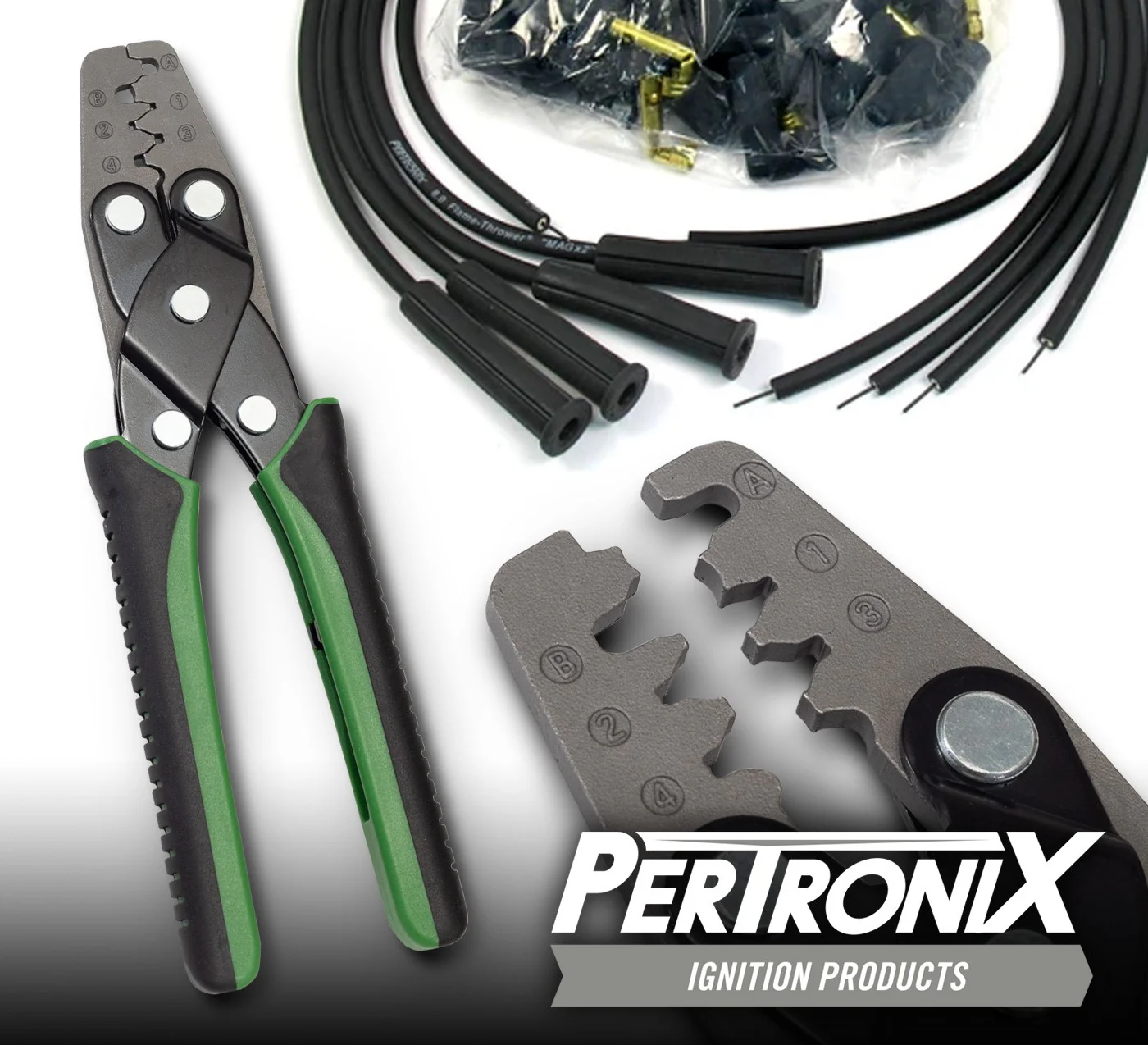How to Crimp Spark Plug Wires
Crimping spark plug wires correctly is not as simple as it sounds, and an incorrectly cut and crimped wire can leave a space between the spark plug wire ends and the terminals. If this happens, there will be a gap between the conductor and the terminal increasing resistance and putting unnecessary strain on the ignition system, leading to spark plug misfiring, reduced gas mileage and acceleration, wear and tear to a catalytic converter.
Carefully reading this article will help avoid these problems and help you choose the right PerTronix ignition products for your project.
Crimp-on Spark Plug EndsMost car enthusiasts and repair shops will buy pre-terminated plug wire kits for their specific year and engine. Unfortunately, they are usually semi-universal, meaning they may not be exactly the right length you’re looking for in a clean install.
If you decide to go off course with the factory plug wiring (meaning you go around the valve cover rather than over it), you may need to build your own custom spark plug wires.
How to Crimp Spark Plug Wires: Tools NeededSpark plugs are an essential part of what makes your vehicle move. They quite literally provide the spark that ignites the air/fuel mixture to create a mini explosion that produces power. The plugs create an electric arc across two leads that are close enough to let electricity jump between them.
A functioning spark plug wire begins with the crimp between the spark plug wire and the wire terminal—thus, you need a crimping tool. Some tools to consider for crimping spark plug wires include:
- Ratcheting crimpers - utilize replaceable jaws
- Pro Crimp tool - specific to crimping
- Stand-alone wire strippers - specific for spark plug wires
- Plug Boots - used for socket-style distributor caps
- Terminal Ends - used for socket-style distributor caps
If you’re just learning how to crimp spark plug wires, be patient with yourself. If you’re an avid car collector or tinkerer, this might be a good refresher. When crimping spark plug wires, ask for help whenever you’re uncertain.
Step 1:
Use a Pertronix stripper to strip the outer silicone layer, leaving about .75-1-inch of conductor wire visible for single-crimp terminals. Note, you’ll need less length for terminals with dual crimp—one for the conductor and one for the silicone jacket.
Step 2:
Determine if you have single- or double-crimp wire terminals. Most traditional socket-style spark plug terminals are brass and single-crimp (the wire conductor is folded back and crimped with the silicone jacket). Double-crimp terminals are less common but occur in modern HEI-style terminals and at the end of the spark plug wire. They’re silver in color and the conductor and silicone jacket must be crimped under separate sections of the terminal body to be functional.
Step 3:
With single-crimp, fold back the conductor over the silicone jacket. At the same time, hold the conductor in place and slip the terminal over the conductor wire. Lastly, position it inside the saddle within the terminal (thus preventing it from slipping out).
Step 4:
Next, with your crimp tool in hand, slide the wire and terminal into it and squeeze firmly until the tabs are folded and crimped to the spark plug wire. Again, ensure you have a solid connection and check the resistance of each wire to ensure continuity. Lastly, slide the boot over the terminal end and repeat for each spark plug. Use of a dielectric grease can make installing the boot easier Congratulations, you’ve successfully crimped spark plug wires.
Double-Crimp Wire TerminalsFollow steps 1 and 2 above when learning how to crimp spark plug wires but consider the following process for double-crimp wire terminals. Note, most of the process is the same except you can get away with less length on the conductor if you’re creating your spark plug wire setup.
Step 3:
With a double-crimp terminal, you have to crimp the conductor and the jacket separately. The conductor is crimped in the smaller area and the silicone jacket is crimped under the larger area. We recommend crimping the silicone jacket first before the conductor.
How to Put Ends on Spark Plug Wires
As with any project, it is important to finish anything you start properly. Again, if you are learning how to crimp spark plug wires, follow all steps carefully and read manufacturer warnings and labels before starting.
The ends of the spark plugs, or terminal, complete the circuit. There are two connection types to consider:
- Most Common - Boot with a larger connector inside, made to snap onto a terminal nut.
- Less Common - Boot that connects directly to the threaded terminal stud
Next, there are three configurations to consider when learning how to crimp spark plug wire ends.
- Removable terminal nut - Removable and used for both threaded stud and terminal nut connections. The plug is made with a threaded terminal stud (or end), then a screw-on terminal nut is added. You can use this plus with either connection type.
- Solid Terminal - Can only be used in conjunction with larger snap-on connectors. The terminal, or end, is part of the design of the plug and cannot be removed. This is the most common type of connection.
- Threaded Terminal Stud - Can only be used with wires and plug caps designed to snap over the smaller threaded stud. This is most common in power sports and motorcycle applications.
Be sure to crimp on spark plug ends at the wire connections and the insulation connect when applicable.
To learn more about how to crimp spark plug wires and the tools needed, check out the wide variety of Pertronix products available today.












